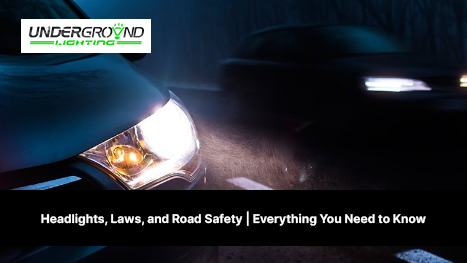Headlights are one of the most crucial safety features of any vehicle. They not only help the driver see the road ahead during low visibility conditions but also make the vehicle visible to other road users. In this article, we will explore the evolution of headlight technology, the importance of adhering to headlight laws and regulations, common headlight problems and solutions, and their impact on road safety.
Importance of Headlights in Road Safety
Headlights play a vital role in road safety by providing illumination during nighttime, foggy, or rainy conditions. They enable the driver to spot obstacles, pedestrians, and other vehicles, preventing potential accidents. Additionally, properly functioning headlights ensure that your vehicle is visible to others, reducing the risk of collisions.
The Evolution of Headlight Technology
- Halogen Headlights
Halogen headlights were the standard for many years due to their affordability and adequate illumination. However, they have certain limitations, such as shorter lifespans and higher energy consumption compared to newer technologies.
- Xenon Headlights
Xenon headlights, also known as High-Intensity Discharge (HID) headlights, produce a bright, bluish-white light that closely resembles natural daylight. They are more energy-efficient and have a longer lifespan than halogen headlights.
- LED Headlights
LED headlights have become increasingly popular due to their energy efficiency, long lifespan, and compact size. They offer excellent illumination and can be designed in various shapes, allowing for unique and innovative headlight designs.
- Adaptive Headlights
Adaptive headlights use sensors and motors to adjust the direction of the light beam in response to the vehicle's speed and steering angle. This technology enhances visibility around curves and corners, significantly improving safety during night driving.
Headlight Laws and Regulations
- Headlight Use and Times
Different regions have specific regulations regarding when headlights should be used. In most places, headlights are required during nighttime and during adverse weather conditions, such as heavy rain, snow, or fog. It is essential to know and follow these rules to avoid penalties and ensure safety.
- Beam Adjustments
Properly adjusted headlights prevent blinding oncoming drivers and provide the best illumination on the road. Regularly check and adjust your headlight beams according to the manufacturer's guidelines and local regulations.
- Significance of Proper Headlight Maintenance
Regular maintenance of headlights is essential for optimal performance and safety. Cleaning the headlights regularly and replacing damaged bulbs or covers ensures that you have a clear and unobstructed view of the road.
Common Headlight Problems and Solutions
- Dimming or Flickering Headlights
Dimming or flickering headlights can be caused by faulty bulbs, wiring issues, or a failing alternator. It's crucial to diagnose and address these problems promptly to avoid sudden headlight failure.
- Cloudy or Yellowish Headlight Covers
Over time, headlight covers may become cloudy or yellowish due to UV exposure and environmental factors. Regular cleaning and using restoration kits can help improve visibility.
- Misaligned Headlights
Misaligned headlights can blind oncoming drivers and reduce your visibility. If you notice that your headlights are not properly aligned, take your vehicle to a professional mechanic for adjustments.
- Upgrading Your Headlights
Consider upgrading your headlights to newer technologies like LED or HID for improved visibility and safety on the road.
The Impact of Headlights on Night Driving
Night driving can be challenging, and properly functioning headlights are critical for a safe and comfortable journey. Adequate illumination helps drivers detect potential hazards and react promptly.
Innovative Approaches to Road Safety with Headlights
- Adaptive Driving Beams (ADB)
ADB technology automatically adjusts the headlight beam's shape and intensity to optimize illumination while preventing glare to other road users.
- Night Vision Systems
Some luxury vehicles are equipped with night vision systems that use infrared cameras to display an enhanced view of the road ahead, even in complete darkness.
- Augmented Reality Head-Up Displays (AR HUDs)
AR HUDs project essential information, such as navigation directions and vehicle speed, directly onto the windshield, reducing the need for drivers to take their eyes off the road.
Best Practices for Headlight Safety
- Regularly Clean Your Headlights
Keep your headlights clean from dirt, grime, and debris to maintain their effectiveness.
- Check and Adjust Headlight Alignment
Ensure that your headlights are properly aligned to avoid blinding other drivers and maximize illumination.
- Replace Bulbs and Covers as Needed
Replace burnt-out bulbs and damaged headlight covers promptly to maintain optimal performance.
- Avoid Blinding Other Drivers
When driving at night, dip your headlights when approaching oncoming vehicles to prevent glare.
Summary
Headlights are an indispensable part of road safety, ensuring that drivers have clear visibility during challenging conditions. The evolution of headlight technology has brought about significant improvements, enhancing safety and driving experience. By adhering to headlight laws, regularly maintaining headlights, and considering innovative safety features, we can contribute to a safer road environment.
FAQs
- Can I replace my halogen headlights with LED headlights myself?
Replacing headlights requires technical knowledge, and it's best to have a professional mechanic do it to ensure proper installation and avoid damaging your vehicle.
- What should I do if my headlights are still dim after replacing the bulbs?
Dim headlights could indicate an underlying electrical issue or a failing alternator. Have your vehicle inspected by a qualified mechanic to diagnose the problem.
- Are there headlight covers that protect against UV damage?
Yes, there are protective films and coatings available that can help shield your headlights from UV damage and keep them clear.
- Can I use my high beams in foggy conditions?
Using high beams in fog can reflect light back at you, reducing visibility further. Stick to low beams or fog lights to improve visibility without glare.
- Do all vehicles come equipped with adaptive headlights?
Not all vehicles come with adaptive headlights as standard. It is often offered as an optional feature or reserved for higher trim levels in certain car models.

